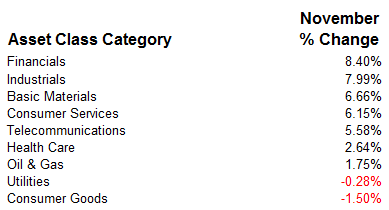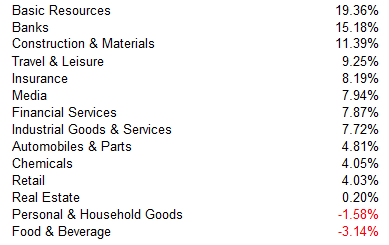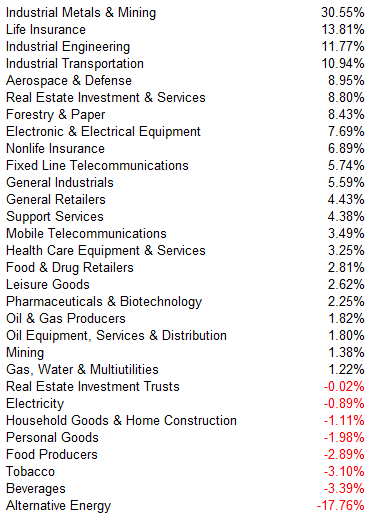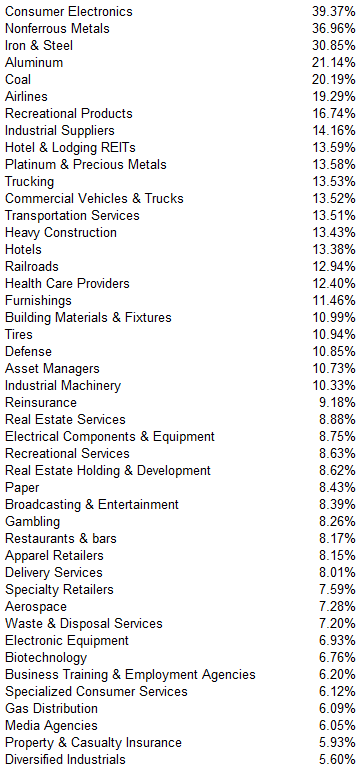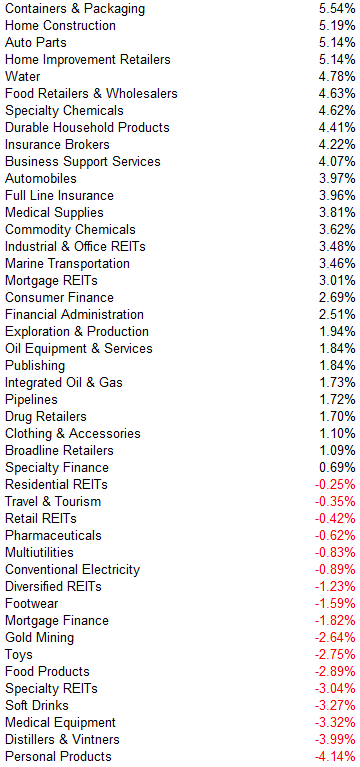What can the early winners and losers in the stock market tell us about the possible impact of a Trump administration on businesses and the economy in 2017?
There are some clear patterns emerging in the price action of certain sectors and subsectors of the market. There are some clear winners and losers. It’s too early to tell whether these trends will last, or fade away. After all, the new administration hasn’t even been sworn in yet. But the early trends are informative nevertheless. Let’s take a look at what has happened in the market during the month of November, 2016.
How the data is organized
Using data from The Wall Street Journal, we divide the stock market into 155 separate categories. The highest level is the Sector level, which divides all 6000 stocks into ten broad categories. In the next level are the Subsectors, of which we have 14. This level gives us slightly more detail than the Sector view, but still gives a very broad view of market action.
The third level is Broad Industry Groups, of which there are 32. More detail, more information, and a better view of the underlying trends in the market.
Finally we have the fourth level – Small Industry Groups. There are 100 of these groups, which gives us fairly granular look at what’s happening. It’s the most detailed view we have, other than looking at every one of the 6,000 stocks that are traded in the market.
Sectors – 10 broad categories of publicly traded businesses
The three biggest winners at the sector level are financials, industrials, and basic materials. The themes at play here are campaign promises made, and taken seriously by investors, to spend huge amounts of money on things like infrastructure and the military, while enacting a massive tax cut at the same time. Investors are betting, correctly I think, that this will stimulate the economy in 2017. But the bond market is less enthusiastic, because it sees much bigger national debt and much wider budget deficits as a result. Bond investors are selling heavily, in anticipation of a potential spike in inflation and a tightening of monetary policy by the Fed.
The losers in November are consumer goods and utilities. These are the sectors that have benefitted the most from low interest rates in the last few years. Investors have crowded into these high-yielding sectors as an alternative to owning bonds. But now that interest rates are starting to rise, these two sectors are losing some of their appeal.
Subsectors – 14 categories of companies that make up the broad sectors above
Continuing the themes that we described above, basic resources and construction firms will certainly benefit from the type of spending Trump has promised. Banks will benefit from higher rates, because this will give them wider profit margins on the loans they make. Deregulation is also at play for the banks, given the campaign promise to kill large parts of the Dodd-Frank act. With fewer regulations, banks can go back to taking higher risks and that could mean higher profitability, at least in the short term.
Food and household goods are considered high-dividend yield plays, and they are losing appeal as interest rates are rising.
Large Industry Groups – 32 industries that make up the subsector list above
Four of the top five industries on this list will benefit from increased government spending. The five losers at the bottom are the formerly popular high yield stocks that have suddenly become less popular.
Small Industry Groups – 100 industries that make up the larger groups above
The top performing group on this list is consumer electronics. It’s an outlier, meaning that it doesn’t exactly fit the themes we’ve been discussing. The reason it came out on top of the list is because one of its’ largest components – Harmon International – received a buyout offer at a hefty premium to its market price.
The rest of the leading groups are directly related to infrastructure spending, the pledge to revive the coal industry, and deregulation. The losers are the same high-yielding companies that investors are selling, in order to pay for the new purchases of companies that they believe will perform better in 2017.
There is one standout loser – renewable energy equipment. Trump, and many of his advisers, have made comments about climate change being a hoax. Whether you subscribe to that belief or not, investors are betting that the companies who manufacture the equipment that promises green energy will suffer under the new administration.
small groups cont’d
small groups cont’d
Final thoughts
It has only been 3 weeks since the election, and there will be many twists, turns, and surprises as the new administration takes shape. These early trends are clear, and significant. But they could reverse as campaign promises bump up against the reality of pushing an agenda through Congress. One of the most vulnerable promises made by Trump is his pledge to spend as much as $1 trillion on infrastructure, and a massive amount on upgrading our military. He may have the great benefit of a Republican Congress to help him get things done, but Republicans are notoriously reluctant to enact big spending bills without some offsetting cuts elsewhere in the budget. This won’t be easy for Trump to pull off.
The bond market is sending a clear message to policy makers that too much spending, coupled with too little new revenue, is a dangerous combination. My view is that the Trump agenda will probably move slowly through the political process, and some campaign promises will have to be postponed or even abandoned.
Next month will give us a fresh look at these trends, and we’ll see which ones continue and which fade away.

